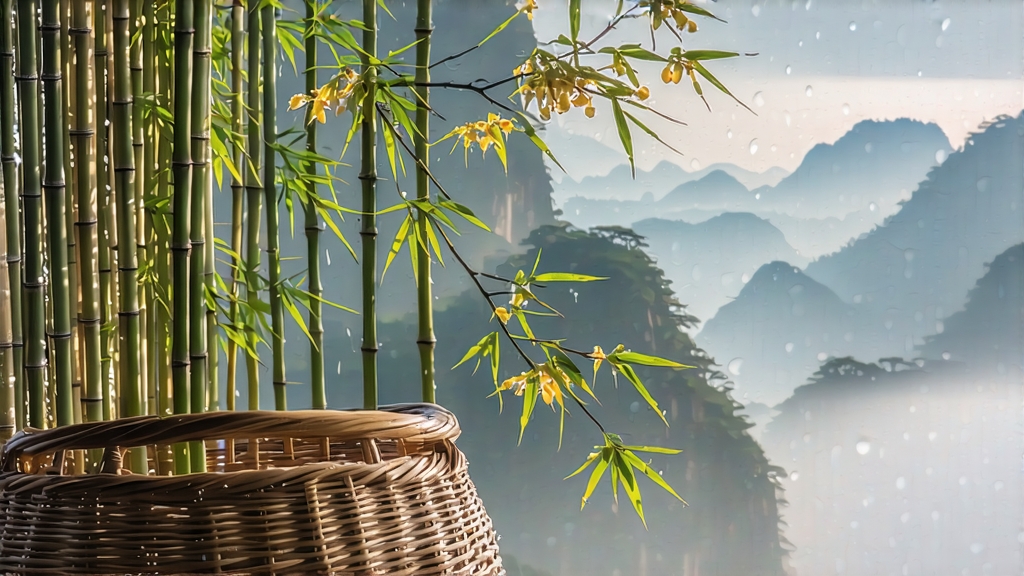
If green tea is the fresh-faced scholar of Chinese teas and pu-erh the bearded sage, then yellow tea is the quiet prince who once sat at the emperor’s table and then slipped into the shadows of history. Among the handful of yellow teas that survive, none carries more imperial pedigree than Mengding Huangya, the “Yellow Bud from the Summit of Meng.” Grown on the mist-locked ridges of Mt. Meng in Sichuan, this tea was already a tribute item in the Tang dynasty (618-907 CE) when caravans carried it southward to Chang’an along the same stone roads that bore Buddhist sutras and Persian silver. A Song-dynasty edict fixed its picking day at the first thunder of spring; Ming court officials measured the leaves against gold ingots; Qing poets compared its liquor to “the first moonlight on snow.” Yet by the 1980s only a few kilos were still being made, and even inside China most drinkers confused it with a green tea. The revival of Mengding Huangya is therefore less a commercial comeback than an act of cultural rescue, one that lets twenty-first-century tea lovers taste the same faint honeyed note that once drifted from the porcelain cups of emperors.
Mengding Huangya belongs to the “bud-yellow” sub-category of yellow tea, meaning it is fashioned almost entirely from the unopened spear-shaped tips plucked in a fleeting three-day window each early April. Standard grade uses one bud and its nearest half-open leaf; the supreme “Imperial Tips” lot is literally just the single bullet-shaped bud, no larger than a fingernail, sheathed in down so pale it looks silver rather than yellow until the moment it is infused. Because the mountain straddles the 30th parallel, the plants awake slowly; on the eve of Qingming the thermometer can still dip to 8 °C, locking amino acids inside the tender shoots and laying the groundwork for the tea’s signature sweetness.
The craft that turns these buds into yellow tea is called sealed yellowing (men-huang), a procedure that walks the tightrope between green tea’s kill-green and black tea’s oxidation. Within two hours of plucking the buds are wok-fired at 160 °C for exactly 90 seconds, hot enough to destroy leaf enzymes yet brief enough to keep the chlorophyll almost intact. While still warm they are wrapped in thick parchment paper and left to suffocate for 40 minutes; the trapped moisture and residual heat nudge the leaf toward a very slow, non-enzymatic oxidation that tints the edges a primrose shade and coaxes out a malty, almost cocoa-like aroma. This wrap-rest cycle is repeated three times, each round lowering the temperature by 10 °C, until the leaf moisture drops to 20 %. A final gentle bake over bamboo charcoal fixes the colour at the hue of old ivory and locks in a fragrance that cuppers describe as “chestnut rolled in dry hay.” The entire process consumes 48 hours and demands that the master read the leaf by touch alone; one extra minute inside the paper and the buds will veer into sourness, one minute less and they remain stubbornly green, forfeiting the golden liquor that gives yellow tea its name.
Western drinkers often ask how Mengding Huangya differs from the more widely available Junshan Yinzhen, the other celebrated yellow tea. Geography is the first answer: island terroir versus alpine terroir. Junshan, grown on a lake island in Hunan, inherits a watery softness, whereas Mengding buds absorb the resinous scent of fir forests and the chill of 1 500 m altitude. The second difference lies in the yellowing itself: Junshan is piled and lightly steamed, yielding a brighter, more floral cup, while Mengding’s parchment-wrap method produces a deeper, brocade-like texture that lingers on the palate like warm custard.
To brew Mengding Huangya well one must respect its dual personality—delicate like a green tea yet rounded like a light oolong. Start with a tall, thin-walled glass or a porcelain gaiwan of 120 ml; yellow tea likes to stand upright and dance. Weigh 3 g of buds, roughly one level teaspoon, and rinse them with 80 °C water for three seconds only; this flash rinse is not for hygiene but to wake the leaf. The first formal infusion uses 75 °C water and lasts forty seconds: pour along the rim to avoid scorching the down, then cover but leave a sliver of air so the buds can expand. The liquor emerges the colour of chardonnay with a faint green rim—an optical signature